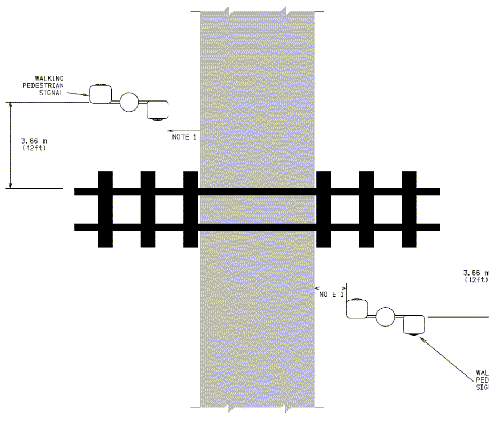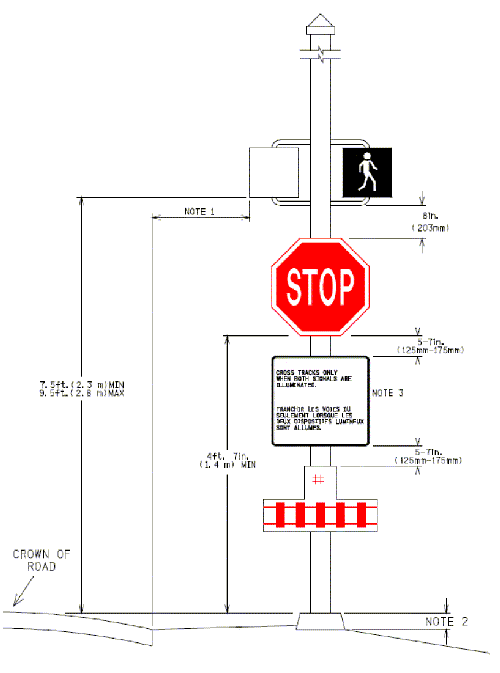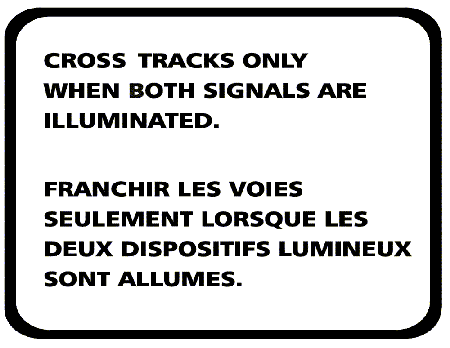All new grade crossings constructed after 2014, as well as existing crossings with new installations, must comply with Appendix C of the Grade Crossing Standards.
TC E-39, February 5th, 2010
Table of Contents
- 1. Purpose
- 2. Definitions
- 3. Relationship to Other Applicable Engineering Standards
- 4. Walk Light Design
1. Purpose
1.1 These engineering standards provide the design requirements for Walk Light grade crossing warning systems to be used at restricted grade crossings.
1.2 Walk Light grade crossing warning system installations will only be used at restricted grade crossings where there is control over the actual crossing users. A crossing assessment will be used to identify these conditions.
2. Definitions
AREMA: American Railway Engineering and Maintenance of Way Association.
AREMA C&S Manual: Communications and Signals Manual of Recommended Practice published by AREMA, as amended from time to time.
Grade Crossing: A road crossing whose road passes across a line of railway at grade.
ITE: Institute of Transportation Engineers.
Restricted Grade Crossing: A grade crossing that is not an unrestricted grade crossing.
RTD10: Road/Railway Grade Crossings: Technical Standards and Inspections, Testing and Maintenance Requirements, established by the Department of Transport, as amended from time to time.
Traffic Control Devices Manual: The Manual of Uniform Traffic Control Devices for Canada published by the Transportation Association of Canada (TAC), as amended from time to time.
Unrestricted Grade Crossing: A public grade crossing or a grade crossing whose road is one of the following:
- a recreation road or trail or a pedestrian or bicycle path maintained by a club, association or other organization, including a snowmobile or hiking trail;
- a road or a pedestrian or bicycle path of a commercial or industrial establishment, including a business operated from a residential or farm property, that is used in connection with the establishment by persons other than employees of the establishment;
- a road that serves three or more principal residences;
- a road that serves three or more seasonal residences access to which is not controlled by a gate equipped with a lock;
- a road that connects two public roads; or
- a road maintained by a resource company such as a company involved in forestry or mining activities.
Walk Light grade crossing warning system: An alternative grade crossing warning system using a walk light signal head and designed in accordance with these engineering standards.
3. Relationship to Other Applicable Engineering Standards
3.1 All of the elements associated with the Walk Light grade crossing warning systems installation shall be designed in accordance with AREMA C&S Manual requirements for Highway Rail Grade Crossing Warning Systems except when in conflict with these engineering standards in which case these engineering standards will take precedence.
4. Walk Light Design
General
4.1 Walk Light grade crossing warning system installations shall be designed and installed in accordance with diagrams 1, 2 and 3 except where the equipment cannot be so located due to local conditions, in which case an alternative arrangement providing an equivalent level of safety shall be used. Diagrams 1, 2 and 3 form part of these engineering standards.
Operating Requirements
4.2 Battery backup for approximately 8 hours shall be provided.
4.3 Power monitor lights shall be provided.
Signal Requirements
4.4 A signal installation as described below shall be located at each road approach to the crossing except where the standard installation cannot be so located due to local conditions, in which case an alternative arrangement providing an equivalent level of safety shall be used.
4.5 The Walk Light grade crossing warning system installations shall include a signal head capable of displaying a Safe to Proceed (Walking Person) indication when trains are not approaching. This will be extinguished when trains are approaching.
4.6 The signal head shall conform with the requirements of ITE “Pedestrian Traffic Control Signal Indications – Part 2” except for the following aspects:
- Utilizes 12VDC pedestrian module instead 120VAC input voltage,
- Operating voltage range is 9 – 15VDC with the unit shutting off at 7.3VDC, and
- Module does not comply with the AC Harmonics and Power Factor portions of ITE which are based on the 120VAC input voltage.
4.7 The proceed signal shall be extinguished a minimum of 20 seconds plus clearance time before the arrival of a train.
4.8 Clearance time shall be based on design vehicle and shall be calculated in accordance with the requirements of RTD10.
4.9 The installation shall not require a bell or any other audible warning.
Signage and Post Requirements
4.10 The signal installation shall be mounted on either a metal pole or wooden post.
4.11 Signage indicating how to use the Walk Light grade crossing warning system as illustrated in diagram 3 shall be posted on the installation post under the walk light signal head as indicated in diagram 2.
4.12 A Stop sign, as specified in the Traffic Control Devices Manual shall be posted on the installation post as indicated in diagram 2.
4.13 Information on the grade crossing ID or location and a number to call in the event of emergency shall be located at each Walk Light grade crossing warning system installation.
4.14 A Private crossing sign shall be posted at each road approach to the crossing.
Diagram 1 – Walk Light Grade Crossing Warning System Layout
Notes:
1: Min 625mm (2ft) from face of curb or from outer edge of shoulder;
2: Min 1.875m (6ft) from edge of the travelled way
Diagram 2 – Walk Light Grade Crossing Warning System Assembly
Notes:
- Minimum of 625 mm (2 ft.) from face of curb, minimum of 625mm (2 ft.) from outer edge of a shoulder and a minimum of 1.875 m (6 ft.) from the edge of the travelled way.
- The top of the warning signal foundation shall not be more than 100 mm (4 in.) above the level of the surrounding ground.
- Restricted Crossing Sign:
- 24" wide by 22" high
- reflective silver background
- silk screened black or vinyl lettering
- 1" high letters
Diagram 3 – Instruction Sign


